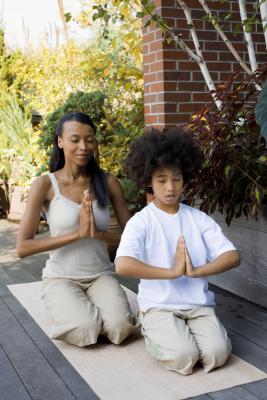Whether your child is stressed, in pain or otherwise upset, relaxation exercises help her handle the situation in a productive way. Teaching your child a variety of relaxation techniques allows her to find the exercises that work best for her in stressful or uncomfortable situations. Repeated practice of the exercises makes them more effective.
Guided Imagery
Guided imagery helps a child relax by visualizing a calming mental image. There isn’t one set way to use guided imagery. If your child is facing a particularly stressful task, she might visualize herself succeeding. For example, before a big race she might visualize herself crossing the finish line and how that might feel. Guided imagery might involve the child imagining herself in a relaxing environment, such as sitting on a beach or floating peacefully on a cloud. Another way to use guided imagery is to imagine a particular color or sensation, such as warmth or light, taking over the body. Have your child sit or lie in a comfortable position during the exercise. Guide her through the mental imagery when she is first learning the technique. After some practice she can use visualization without your verbal cues.
Yoga Poses
Yoga is often used by adults, but children can also benefit from its relaxing qualities. Basic yoga poses work on controlled movements and breathing. Regular yoga offers a gentle form of physical activity in addition to the relaxation it provides. Many yoga poses help improve strength, coordination and body awareness. Improving these areas can help your child feel more confident, which could reduce overall stress levels. In addition to regular yoga practice, suggest a few poses whenever your child shows signs of being upset or stressed as a way to calm down.
Controlled Breathing
Controlled, purposeful breathing is another option for relaxation. Teach your child to find a comfortable position, either sitting up straight or lying down. Breathe in and out slowly and deeply while counting to a set number like 10 or 20. Closing the eyes and relaxing the muscles increases the relaxation of this exercise. At first you might need to remind your child to breathe when she becomes upset until it becomes a habit.
Progressive muscle relaxation also works well with breathing. As your child breathes deeply, she tenses then relaxes a particular muscle group. The exercise usually starts at either the head or the toes and works to the other end, progressing through the muscles in each part of the body. For example, you might guide her into tensing and relaxing the muscles of the toes, feet, calves, knees, thighs and so on up through the face.





